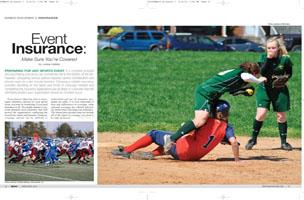
 |
| Photo courtesy of Bill Gates |
Preparing for any sports event is a complex process and purchasing insurance can sometimes fall to the bottom of the list. However, comparing various options requires careful consideration and should never be a last-minute decision. Choosing a reliable insurance provider, deciding on the types and limits of coverage needed and completing the insurance applications are all steps in a process that will ultimately protect your organization should an incident occur.
If you haven’t taken the time to investigate insurance options for your sports event, you may be wondering if you need insurance at all. The simple answer is yes; event planners need insurance that will protect the organization conducting the event from claims and lawsuits. However, coverage options can be difficult to understand and not all insurance programs are alike; it is very important to note any differences in coverage, what optional coverages are offered, and policy limits when choosing your insurance. The lowest price product may not include all of the types of coverage you need to be fully protected. Even if the coverage is comparable, low-cost policies are not a bargain when considering additional service charges for certificates of insurance, or for adding “additional insureds” to the policy.
 |
| Photo courtesy of Beals Alliance, Sacramento, CA |
Additional Insureds
An additional insured is an entity which has an insurable interest for claims arising out of your negligence as the named insured, such as the venue where your event will take place. A certificate of insurance is provided to the additional insured providing proof of coverage. If you are an event organizer, the facility may require you to show proof of liability and list them as an additional insured to your policy. This will protect you, the named insured, and the venue/facility for defense and indemnity costs (if policy limits have not been exhausted) brought by a third party (spectators) and/or by participating teams.
This is a very common request and, unfortunately, can sometimes be a source of added costs from insurance providers who charge an extra fee for certificates of insurance, sometimes as much as $25 to $50 for each certificate requested.
 |
| Photo courtesy of Bill Gates |
Insurance Coverage Definitions
There are many types of coverage needed for various entities involved in sports events. For example, teams and leagues should purchase insurance designed to protect the organization, including its employees and volunteers. An organization hosting a tournament needs liability coverage that includes employees and volunteers, and facilities hosting events need their own insurance coverage as well. In addition, coverage may be necessary for ancillary activities associated with the event, such as banquets, concerts, awards ceremonies.
So what types of coverage should be considered when planning a sport event? Let’s start with some basic coverage descriptions:
 |
| Photo courtesy of Bernie Clasing |
Commercial general liability protects the insured against liability lawsuits or claims, from a third party, for bodily injury and property damage arising out of the insured’s premises and operations. Defending your organization against and paying for a liability claim is expensive. Liability insurance not only pays for damages you are held legally liable for, but should also cover the cost of investigation and defense of claims, even if they are groundless. Always ask your insurance provider if defense costs are outside of your limits of coverage; if they are included, legal costs may quickly burn through your coverage limits. Commercial general liability may include:
• Products-completed operations generally protects the organization from claims related to the manufacture or sale of products to the public. It may cover the seller's liability for losses or injuries to a buyer, user or bystander caused by a defect or malfunction of the product)
• Personal and advertising injury (covers an injury to a third-party brought about by the insured business advertising its goods and services, usually by copyright or trademark infringement or due to libel, slander, or invasion of privacy)
 |
| Photo courtesy of Bernie Clasing |
• Legal Liability to Participants protects against bodily injury liability claims brought by persons participating in covered sports activities. Professional liability provides protection for claims arising out of the rendering or failure to render instruction, demonstration, direction or advice relating to the sports activity.
• Medical payments for participants coverage pays medical and dental expenses incurred by a participant when accidental injury occurs while participating in covered sports activities (this coverage is usually on an excess basis, after all other medical coverage available to the participant has been exhausted).
In addition to liability coverage, sports organizations want to consider inland marine coverage, sometimes called equipment and contents coverage. This provides coverage for direct loss or damage to sports equipment, field maintenance equipment, concession stand equipment and portable storage sheds.
 |
| Photo courtesy of Bill Gates |
Sports organizations may also be able to purchase other optional coverages such as hosted tournament coverage or directors’ & officers’ liability coverage. Depending on the size and activities of the organization, additional liability coverage and other insurance products such as property, commercial auto, crime, and excess liability may be needed. Working with a licensed insurance professional is always the best option when making decisions regarding complex insurance coverages; an experienced provider will understand how various types of insurance interact to provide adequate coverage.
Choosing Coverage Limits
The policy “limit” is the dollar amount of protection purchased and will receive when there is a claim. For example, you may choose to buy a policy that offers a $2,000,000 occurrence limit with a $4,000,000 aggregate limit. This means that your limit for an individual incident (an “occurrence”) is $2M with a total (“aggregate”) limit of $4M for all incidents occurring while the policy is in effect. Facilities or tournament hosts may mandate minimum limits, which can vary. Before purchasing coverage, be sure to check contracts or agreements you have with facilities or other associated organizations for insurance requirements.
 |
| Photo courtesy of Bill Gates |
Financially Sound Providers
The financial stability of your insurance company is very important; always ask for the financial rating of the carrier. A high rating (A or better) by an independent rating company such as A.M. Best Company is the safest choice. Also, choosing a carrier that is “admitted” (licensed) is preferable because choosing an insurance company that is non-admitted (called surplus lines) may require you to pay extra fees or taxes. Guard against shopping on price only.
Finally, the experience and knowledge of the carrier should be considered. Companies familiar with the unique risks associated with sports organizations and events will be able to accurately price coverage and more importantly, provide prompt and reliable claims handling services. You may also want to look for convenient services such as the ability to apply and purchase coverage online, as opposed to completing a paper application that must be mailed and approved before coverage is in force.
Purchasing the right type and amount of insurance will ultimately give you peace of mind when preparing for your next event. Choose the right liability coverage for your sports organization and you’ll be able to focus on other details, knowing that you’ve got the coverage you need.

